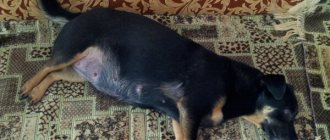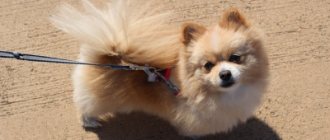Like all dogs, Pugs exhibit varying signs and symptoms throughout pregnancy. This process usually lasts about 63 days.
Gestation of puppies is divided into three stages: early, middle and last. Each lasts approximately 20 days and involves obvious changes in your dog's behavior.
Whether the mating was planned or the pregnancy was accidental, this article will teach you how to recognize the signs and symptoms and care for your pet.
Features of pregnancy in pugs
Several important features of pregnancy in a pug dog:
- The first heat in pugs begins between 6-12 months. However, experienced breeders do not recommend breeding a pet until it is two years old. Otherwise, the animal will experience serious complications during the birth of the pug pups.
- The normal gestation period for a pug is 57 to 67 days. If it lasts longer in your pet, you need to urgently take him to a veterinarian.
- On average, a female gives birth to 3-5 puppies at a time. But 1 or 7-9 pugs at a time is also considered the norm.
- Sometimes a dog experiences a phenomenon called a false pregnancy.
- You should not breed pugs more than once a year. The female needs time for physical and emotional recovery.
- To find out if the female is pregnant, you need to visit a veterinarian. This cannot be determined using a test for humans because dogs do not have the hCG hormone.
False
A false pregnancy has all the signs and symptoms of a real one. It usually occurs if the fertilization process is not complete. The embryo did not conceive, but the body thinks otherwise. This is not a disease, just a special psychological state of the animal. It can arise out of nowhere, even if there was no mating with a male dog.
Timing of appearance and symptoms
Symptoms of false pregnancy that occur 4-9 weeks after estrus:
- Nervous and restless state.
- The dog begins to “nest.”
- Protecting imaginary puppies.
- Loss of interest in food, walks, toys, etc.
How long does it last?
After a couple of weeks, the animal comes to its senses on its own. With the help of the owner, you can get out of this state faster:
- Do not give dairy products that stimulate milk production.
- Reduce the amount of food you eat.
- Do not allow contact with small puppies.
- Distract yourself with walks and other physical activities.
- Remove all toys.
Usually these methods help, but if the false pregnancy continues, you should consult a specialist.
How can you tell if a female is pregnant?
Vivid signs of developing pregnancy in a female are observed in the second half of pregnancy. These include symptoms such as:
- sharp and frequent fluctuations in appetite. The dog either refuses to eat or begins to really want to eat and constantly ask for more;
- the female begins to sleep more, becomes less active and inquisitive;
- the animal’s mammary glands swell and acquire a rich pink color;
- Colorless or whitish mucus is occasionally discharged from the external genitalia;
- Some pugs develop toxicosis.
To make sure that the dog is pregnant and is about to give birth to puppies, you need to visit a veterinary clinic. This will establish the fact of pregnancy and exclude false pregnancy.
Duration of wearing
On average, dogs carry puppies for 60 days, about 2 months.
Larger breeds bear cubs for 62 - 63 days, small dogs for about 58 days.
By the 25th - 30th day of a dog's pregnancy, the skin in the area of the nipples turns pink and they swell.
- after 33 days there is an active increase in the abdomen;
- closer to the day of birth, the stomach drops;
- active greenish or yellowish discharge is observed from the loop;
If this is your pet’s first pregnancy, then perhaps she will begin to produce milk a few days before giving birth; if she is already an experienced mother, then nipple discharge may be observed as early as 13 weeks.
How to care for a pregnant dog?
A pet expecting offspring requires special care. And first of all, this applies to changes in diet, adherence to activity and rest. If improperly cared for, the female often develops severe swelling of the mammary glands and hind legs.
Feeding a pregnant pug
During gestation, the female undergoes a global restructuring of her body. Nutrition and vitamins in this case directly affect the course of pregnancy and the development of embryos.
If you feed your pet natural products, you can continue to give her her usual diet, the main thing is that meat and meat by-products make up at least 2/3 of the total diet.
If your pet eats ready-made dry food, you need to slowly introduce natural products into the regular diet. And the main one is raw meat. It could be beef, turkey or not too fatty lamb. In addition to meat, the female should be given raw egg yolk, cheese, goat's milk and natural yogurt 2-3 times a week. Milk protein normalizes the growth of fetal tissue and maintains the health of the expectant mother.
Another important addition is vitamins and microelements. The main supplements for pugs during pregnancy include:
- Fatty acid. This is the omega-3 found in fish oil. It is better to give the female omega-3 in capsule form.
- Folic acid. This is a B vitamin that prevents developmental defects in the fetus and promotes its proper formation.
- Calcium. This mineral is directly involved in the formation of skeletal bones and teeth. Calcium should be added to the diet taking into account the needs of both the female and the fetus. However, an excess of this microelement is harmful: because of this, the production of hormones is suppressed.
During pregnancy, the pug should be fed not twice, but three times a day.
Physical activity and rest
Low mobility of the dog will lead to severe swelling and weakening of the muscles. Therefore, a female puppy should be walked daily and for at least two hours. The sun and fresh air will have a positive effect on the animal’s well-being.
The main thing is not to allow the girl to lie on wet grass or on a cold surface. You can’t run up the stairs or jump off.
Vaccination during pregnancy of a dog
The dog requires one vaccination per year and preliminary deworming. If the time of vaccination coincides with the onset of estrus, it is necessary to vaccinate a little earlier. And then the born offspring will already have antibodies passed on from the mother.
It is impossible to deworm a pregnant female; in extreme cases, this can be done before the third week of gestation. The opposite threatens miscarriage. Therefore, when planning a mating, you need to rid your pet of worms in advance.
Treatment of skin folds
Muzzle . The pug's folded face also requires care. Sweat, dust, and discharge from the eyes accumulate in the folds, causing an unpleasant odor and irritation. The folds are cleaned with special hypoallergenic wet wipes, cotton pads soaked in alcohol-free lotion for baby skin, hydrogen peroxide, chlorhexidine solution and sprinkled with baby powder. It is enough to carry out the procedure once a week, but if the folds are massive and impede air circulation, then you need to clean the folds twice a week.
Nose . The tip of the pug's nose also requires care. Its skin is dry and prone to cracking. Therefore, the nose also needs to be nourished - lubricated with baby oil.
If the skin in the folds is inflamed, then experienced dog breeders recommend treating the inflammation with Levomikol or Malovit ointments. They eliminate pimples, diaper rash, and irritation. But before treatment, you need to consult a veterinarian, since the cause of inflammation can be demodicosis, a disease caused by a skin mite.
The first signs of labor in a pug
Harbingers of the onset of labor are the breaking of water and gradually becoming more frequent contractions. You can find out that a pug is giving birth by a number of other signs. This includes a change in behavior, drooping of the abdomen and a decrease in the animal’s temperature to 37 degrees Celsius.
Pug contractions
The duration of prenatal contractions ranges from 12 to 24 hours, after which pushing begins. Typically, in dogs giving birth for the first time, they last more than 20 hours. It is imperative to note the time between contractions to understand whether the female is ready to give birth. If the contractions stop on their own, or the intervals between them are very long, this indicates a false birth.
There should be no more than an hour between contractions and pushing. The opposite indicates that the pug is stuck in the birth canal. In this case, the dog cannot give birth on its own and urgent assistance from a veterinarian is required.
Pug behavior before giving birth
Before giving birth, the female's behavior changes noticeably. The animal becomes restless, begins to rush around the house and cannot find a place for itself. The dog often licks itself and whines. In addition, the pet completely refuses to eat, becomes apathetic and lethargic.
Brief history of the breed
The origin of pugs is unknown for certain. It is believed that they originated in China, where dogs with short muzzles were always in demand. The first descriptions were compiled about 3000 thousand years ago: dogs lived at the court of the emperor, had their own guards and servants. In the 16th century, Dutch traders brought animals to Europe, after which this breed became loved in England - noble people were happy to have sociable pets.
But in the 19th century, the popularity of dogs began to wane. The history of the pug breed took a new turn after recognition by the dog breeding community and the adoption of an official standard in 1897.
Preparing a pug for birth
To fully prepare for the upcoming birth of a pug, you will need to take care of several things:
- The first and one of the most important is the construction of a house for the expectant mother and her pugs. You can use a regular cardboard box. To do this, you need to cut an inlet hole on it at a height of about 12-14 centimeters, which will close like a door. Inside the house you will need to cover the bottom. Thick foam rubber (about 5 centimeters), a warm blanket and light cotton fabric are suitable for this. It is also necessary to make a removable roof for the house (for example, lay a sheet) so that you can watch the pug and her kids.
- Another box that will be needed is a temporary bed for newborn pugs (a kind of incubator). You need to put a heating pad in it, because hypothermia is deadly for them.
- The room where the birth will take place must be warm, without drafts.
- It is better to choose a low table for the immediate birth place. It is necessary to take care of the fences so that the giving birth dog does not fall from it.
Vaccination
that pug girls be vaccinated in advance, before mating. But sometimes mating happens unplanned, and vaccination needs to be done. What to do?
According to the instructions of the famous French manufacturer about the complex vaccine, this procedure is allowed in the first third of pregnancy, i.e. up to 20 days. The instructions also indicate that this procedure is contraindicated for sick and weak animals.
If the expectant mother experiences toxicosis, postpone the vaccination until later. Caring owners prefer not to risk the health of their pet and future children - they postpone vaccination until a later time. When babies turn 2 months old, the whole family is taken for vaccination.
What is needed to give birth to a dog?
To give birth at home yourself, you will need to prepare a whole list of things:
- you need to prepare several light, soft cotton napkins or sheets;
- you need to prepare gauze swabs (but not cotton swabs). They will be needed to wet the mouths and noses of newborn pugs;
- prepare two baths for water. One for cold, one for hot. This is in case there is a need to carry out resuscitation measures;
- put nearby sterile scissors, cotton wool, a jar of brilliant green and disinfectants (for example, Chlorhexidine), an ampoule of No-shpa for pain relief. It is recommended to have Oxytocin to prevent large blood loss;
- prepare cotton threads for ligating the cut umbilical cord;
- It wouldn’t hurt to have Vaseline or Syntomycin on hand if your dog needs help with a massage.
How to give birth?
Accepting the onset of labor is a responsible task, but there is no need to panic or worry excessively. The owner's excitement is transmitted to the dog. How should childbirth be delivered? First of all, you need to understand that not every pug will need help in giving birth. While everything is going well, the owner must carefully monitor the course of events and be ready to instantly come to the dog’s aid.
Whether intervention will be needed during labor depends on the position in which the puppy is born:
- If the baby comes out with his butt forward and his back to the mother’s back, this is the most favorable option. If the puppy walks butt forward, but is facing the other way, you can help him: to do this, lightly grab the baby by the fur and pull. But under no circumstances should you pull the hind legs or tail.
- If the puppy walks sideways or with its belly up, you need to carefully bend it and help it out in accordance with its position.
- If the puppy comes out head first, you need to free his muzzle from the diapers and try to grab him by the scruff of the neck. Holding him this way, straighten his paws with your fingers and slightly pull him up.
- If a pug, walking butt forward, gets stuck halfway, there are two ways to help. The first is to take him by the scruff of the neck and begin to swing him slightly from side to side. After these actions, the shoulders should come out one after another. The second method is to insert a finger (parallel to the puppy) and straighten its front legs. Next, you need to carefully and slowly pull it. It is important not to bend the new puppy into an unnatural position.
Sometimes the female cannot bite off the umbilical cord on her own. In this case, the owner will need to take sterile scissors and thread. You need to cut the umbilical cord at a level of three to four centimeters from the puppy’s tummy, then tie it with a thread at the end.
As soon as the next pug goes, move the first one to a warm box prepared in advance.
After the end of labor, the female will want to eat. This is an indicator of a successfully completed birth.
How do pugs give birth?
Contractions are often, but not always, accompanied by heavy breathing and chills. In addition, the dog will try to dig.
The beginning of pushing is accompanied by tension in the abdominal muscles. It becomes hard. Gradually the attempts intensify, subsequently passing in a series in a row. At this moment, the animal must be in the place for birth (on a table, sofa, in a box, etc.)
When pushing, the dog either lies or sits in a position characteristic of relieving itself.
The stronger the attempts, the more the pet changes. She will begin to throw her head back and move her tail to the side.
Postpartum period
Within 2-3 weeks after the removal of the placenta, the dog continues the postpartum period - involution or reverse development of changes in the genitals, endocrine, nervous, cardiovascular and other systems that occur in a dog during pregnancy. Additionally, as a result of lactation, the function of the dog’s mammary glands increases. The configuration of the dog's abdomen remains the same. The vulva and vestibule of the vagina take on the same appearance as before pregnancy. Swelling occurs, pelvic ligaments thicken, the uterus contracts and flattens to 1-1.5 cm (in large dogs), decreasing 10-15 times with the release of lochia (remnants of fetal fluid, blood, epithelial cells, uterine gland secretions) within 12-13 days. The cervix closes after the uterus is cleared of lochia. In the ovaries, degeneration of the corpus luteum of pregnancy occurs, and then the maturation of follicles. With poor feeding and maintenance of females, with a lack of walks, the processes of involution of the genital organs can be delayed, as a result of which various postpartum diseases are possible (acute postpartum endometritis in small domestic animals, salpingitis, etc.).
What complications may occur during childbirth?
A dangerous complication that you may encounter is the pug getting stuck in the birth canal. In this case, the dog will need urgent help from the owner.
To make sure that the baby is stuck, you need to monitor the time interval of birth. Normally, puppies are born twenty minutes after the previous one. If it is clear that the animal is suffering, it is necessary to help the fetus come out.
In addition to getting your puppy stuck, other dangerous conditions during labor include:
- absence of labor, although the due date has already approached;
- painful attempts that do not lead to birth;
- stillbirth;
- retention of the placenta, observed after the birth of all puppies.
Temperature
About a day before giving birth, body temperature drops by one degree. The temperature returns to normal with the birth of the last puppy in the litter (38 degrees). After some time it may rise to 39 degrees, but not for long.
If the indicator reaches 40 or higher and lasts for several days, then you need to start sounding the alarm. Perhaps there was a dead puppy in the womb.
If during labor the body temperature does not fall, and the mark on the thermometer only creeps up and the figure reaches 38 degrees or higher, then a doctor is urgently needed. This indicates an inflammatory process.
If the temperature has dropped very low, and childbirth is still far away, then this may be a threat of premature delivery or miscarriage.
How many puppies does a pug give birth to?
The birth of small puppies is a great joy and relief for the female. One pug litter most often contains three to five babies. However, the norm is a number from one to nine.
For the first time
It is impossible to predict how many puppies there will be in a pug's first litter. An ultrasound scan of the dog will provide information about their health and proper development.
On subsequent occasions
The number of puppies in the litter does not depend on how many times the bitch gave birth. From one to nine babies are born at a time.
Factors influencing growth
The rate of growth and development of a puppy depends on many things:
- Genetic factor, heredity.
- Environment, living conditions at a young age.
- Balanced diet.
- Sufficient physical activity.
- Timely deworming - helminthic infestation inhibits the development of puppies.
It is important to ensure that the kitten does not suffer from an excess or lack of vitamins and mineral elements:
- Vitamin D deficiency is the cause of rickets, bone deformation, and developmental delays.
- The correct ratio of calcium and phosphorus is 1.2:1. An excess of calcium is also a reason for the slow development of an animal.
Caring for puppies after birth
When born, tiny pugs do not yet see or hear, and they have no teeth. Babies have two instincts: to suck milk and crawl to the warmth of their mother. But it happens that puppies cannot perform these actions on their own. And then we need to help them. Care that needs to be organized for puppies:
- The box in which they will be placed should be warm and spacious. This is necessary for free movement and ease of feeding with milk. You also need to remove folds on the soft surface so that the puppies do not get entangled in them.
- Use a heating lamp for heating. Place a thermometer in the box to monitor the temperature. Watch the kids themselves: their behavior will let you know when they feel uncomfortable. If puppies sleep tightly huddled together, this means they are cold.
- After the babies are born, you need to keep a table of their growth and condition. Children's or kitchen scales are suitable for weighing. It is necessary to note the body weight of each baby in order to track the dynamics.
Reviews
Valentina, 27 years old
I had to deliver my pug myself. I planned for a veterinarian to do this, but we didn’t have time to get to him. In principle, nothing difficult if you prepare in advance. She gave birth to me for the first time, there were only three puppies. Everyone is healthy and strong.
Elena, 30 years old
The birth was difficult. My dog is already 7 years old, I think this is the last time. The pregnancy was multiple, 8 puppies, two of them were very weak. My girl became weak during childbirth, I had to feed her warm broth and take her outside.
Maria, 31 years old
My pet gave birth quickly and without problems. The difficulties began later. We didn’t do an ultrasound, so we couldn’t even imagine that there should have been more puppies than were born. She had a high fever for several days, we thought this was normal. Then they finally decided to see a doctor, it’s good that it was on time. They managed to save the dog.











